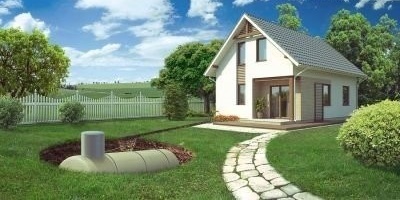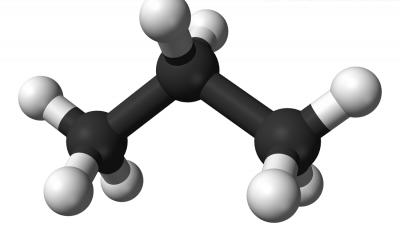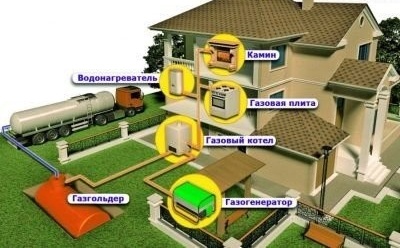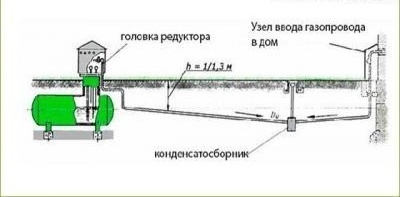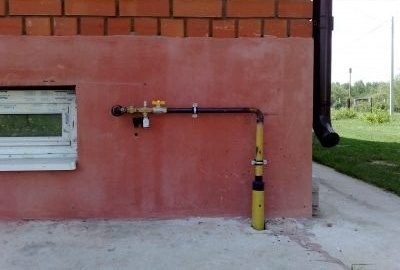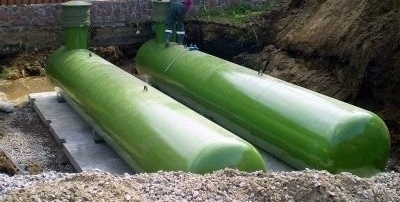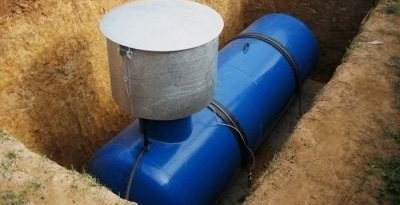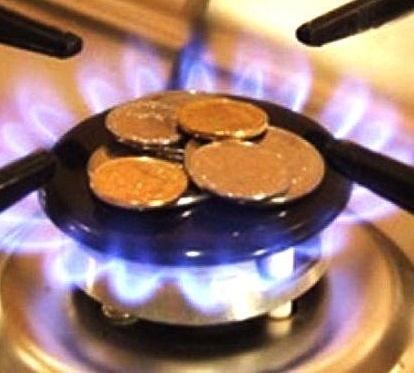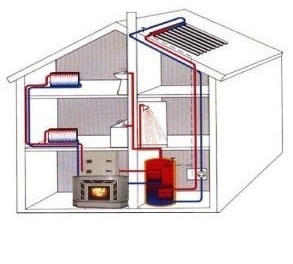Individual heating of a private house with liquefied gas
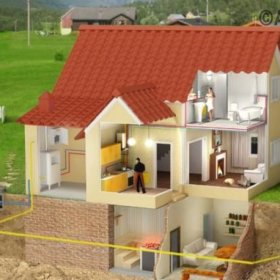
Gas heating remains the most reliable and cheapest way to heat your home. In the climatic conditions of our country, it is the most consumed source of energy.
Content
Autonomous gas heating systems
The use of natural gas is relatively inexpensive and safe compared to other sources of thermal energy. Modern gas equipment is able to automatically ensure optimal consumption of blue fuel and maintain comfortable conditions in the building.
The reasons for using autonomous gas supply systems may be the following circumstances:
- lack of access to the main gas pipeline;
- the high cost of designing and supplying gas from it to the house;
- errors in the construction of a private house, in which the connection of the main gas is impossible for security reasons. The requirements for the design and operation of autonomous systems are much milder.
For autonomous gas supply, the project is developed individually for a particular building. In this case, the developer may be offered the choice of a fuel supply source: a gas holder or household gas cylinders.
Autonomous gas equipment is often installed even in homes where there is central heating. Such a device allows you to control the heating mode and save money on heating. An autonomous heating system from gas cylinders is cheaper both in terms of equipment cost and gas price.
Video: propane-butane heating
LPG Properties
Gas for cylinders is somewhat different from natural main fuel. It is characterized by:
- higher efficiency;
- low cost of fuel;
- ease of use;
- the ability to use a variety of equipment.
This propane-based fuel is produced.It is safe for human health and does not have a harmful effect on the environment.
Chemical formula - C3H8 - talks about hydrocarbon class alkanes. The natural source is natural gas, which is released by cracking petroleum products in the separation of associated petroleum gases as a by-product.
In its pure form, propane does not have any odor, and specially introduced additives give it a well-known aroma. They are used for identification in the formation of leaks. Propane has low toxicity, but has a weak narcotic effect on the central nervous system.
Propane Applications
The most extensive use of propane is as a fuel. It is used:
- in industry - for the performance of gas-flame works and welding of metals in non-essential structures;
- in construction - for heating industrial and facility premises;
- in road works when heating bitumen and the surface of the roadway;
- in food industries - in gas stoves and water heaters.
One of the new applications of propane is its use as automobile fuel. It is cheaper than gasoline or diesel fuel and has a positive effect on increasing the life of internal combustion engines.
Calculation of the need for liquefied gas
Preparatory measures for the installation of this type of gas equipment are very responsible. Miscalculations of an insufficiently qualified designer or low professional training of builders subsequently are very expensive. Heating systems do not achieve passport characteristics, and to ensure normal living conditions have to increase fuel consumption.
Starting to purchase equipment, you must make sure that it meets the needs of the home. To do this, you can use the practically established ratio. To provide quality heat, you need to spend one kilowatt-hour of thermal energy for every 10 square meters of heated rooms. In this way, you can get primary data about the required power of the boiler.
Considering the range of products offered on the market, you need to choose a product that is suitable for the parameter obtained.
It should be borne in mind that the value obtained in this way applies only to heating, the consumption for other gas appliances must be calculated separately, taking into account the intensity of their use.
Autonomous gas supply device
As mentioned above, gas supply systems for liquid fuel are of two types: gas and gas.
Gas supply with gas tank
The gas holder is a sealed container filled with a liquefied propane-butane gas mixture. During operation, propane is released in the vapor phase and fills the free space in the tank. From here, through the gearbox, it enters the outdoor gas pipeline. The reducer is designed to lower the pressure in the gas pipeline system to the technological standard.
To install the device on the site, you need:
- Dig a hole corresponding to the size of the gas tank. Its depth should be greater than the corresponding parameter of soil freezing for the installation site by 30–40 cm.
- At the bottom of the pit, pour a drainage layer of gravel and sand.
- Lay or pour concrete slab on top of the drainage layer.
- Install stainless steel anchors on the stove.Their purpose is to attach the tank to the base, preventing its ascent in the conditions of spring flooding.
After filling the pit with a tank, only the neck protrudes to the surface, on which control and regulation equipment is installed.
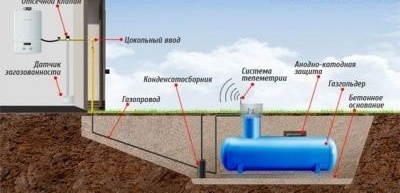
After installation and fastening of the gas tank to the concrete slab, it is covered with earth so that only the filler neck with control and recording equipment remains at the top
Anodic-cathodic protection is intended to protect the container body from corrosion of electrochemical origin. For this, a tread device with an activator is installed in the pit. A tread is an anode made of an alloy based on magnesium, placed in a bag of cotton fabric, where the activator is filled. Its composition: somite and gypsum building - 25% each, the rest - bentonite clay. The anode is connected to the tank body with a wire.
The action of the device is based on the formation of a potential difference between the anode and the housing, as a result of which recovery reactions occur on the housing. The life cycle of the gas tank housing increases several times.
An indispensable condition for the operability of the system is a condensate collector. It is formed from butane vapor in vertical areas when used in winter conditions. The condensate collector is installed at the bottom of the system, a pipe is diverted outward from it. If condensate is not removed, system operation can be stopped by the resulting butane plugs.
The tank is installed at a distance of 5-10 meters from the house and is connected to it by a pipeline in the ground.
Video: gas tank installation
Outdoor gas pipeline
For the installation of an external gas pipeline, a pipe of low pressure polyethylene without joints is used. Such pipes are most often supplied in bays, so it is not difficult to find a product of the desired length.
The main advantages of polyethylene pipes compared to metal pipes are as follows:
- jointless execution - joints have always been a weak point of any pipeline, especially working under pressure;
- flexibility - the pipe easily copes with soil movements during its seasonal movements;
- the life cycle of such a product far exceeds that of metal counterparts.
Connection to the internal gas supply system is made through the basement base with the mandatory installation of a shut-off valve.
The base connection is a connection of a polypropylene pipe and steel. It is made using a special case. An obligatory input element is a “weld-in” tap and a siphon device to compensate for possible movements of the foundation and soil heaving during freezing.
Internal gas pipeline and security systems
Inside the house, distribution wiring is created to supply fuel to consumption points. It is made of steel water and gas pipes in accordance with GOST 3262–80 with a minimum number of connections. Pipe wiring is carried out in accordance with a developed and approved project. The right to perform technical documentation is confirmed by the corresponding certificate.
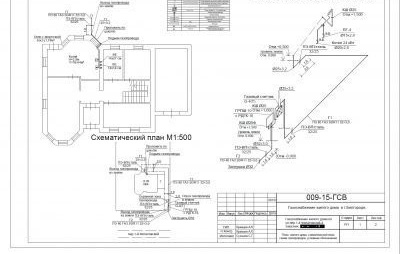
The autonomous gas supply project indicates the complete gas pipeline arrangement from the place of installation of the storage tank to each consumer
Mandatory elements of the distribution of intra-house wiring are the following devices:
- gas contamination level sensor - continuously checks the presence of gas in the room. The level of response is the achievement of 20% explosive concentration. Sound and light signals are given, the automatic shut-off valve of gas supply to the distribution system is triggered;
- thermal shutoff valve - designed to shut off the gas supply in case of fire in the room. It works when the temperature rises to 90–100 oC;
- A device for remote control of the gas level in a gas tank. It is usually completed as an option.
Photo Gallery: Gas Line Monitoring Devices
- Gas analyzer monitors exceeding safe level of gas concentration in the room
- The shut-off valve shuts off the gas supply when the temperature rises at the installation site.
- Thermal shut-off valve closes the gas supply line in case of fire
Video: autonomous gas supply
Using more than one gas supply tank
Sometimes it is practical to install several gas holders. They can be used both individually and interconnected in liquid and vapor phases. This allows you to increase the volume of stored gas and increase the area of its evaporation. The connected containers can be refilled either singly or several at the same time.
Twin tanks allow more efficient regulation of the gas supply control mode and increase the refueling period.
It should be remembered that the gas holder must be installed no more than forty meters from the location of the refueling tank.
Gas consumption with autonomous heating
To decide on the installation of individual gas supply, it is necessary to evaluate a number of factors that can have a significant impact on the efficiency of the system:
- regional climate features, the duration of the heating season;
- the size of the heated area;
- materials of ceilings and walls and their ability to withstand unproductive heat loss;
- the area of windows and other translucent structures;
- own preferences for temperature conditions;
- nature of residence - permanent or temporary;
- operation of backup and auxiliary gas equipment - gas stoves and columns, gas generator.
As a rough preliminary estimate of the gas demand, it is possible to use an indicator of 26-30 liters per square meter of area in the calculations.
Video: heating with liquefied gas (propane) - consumption, experience using
Pros and cons of autonomous gasification
The energy output of the gas is through its combustion. In this regard, this type of fuel is considered to be explosive, which encourages strict control of its use. Therefore, after deciding on the installation of an autonomous system in a country house, you should entrust its design and installation to qualified performers with the appropriate licenses to perform work.
Autonomous gasification is a technically complex system in which all components and systems provided for by the project are mandatory. Their exclusion from the design or replacement with cheap analogues is fraught with grave consequences.
Cons of autonomous gasification systems
Such devices free the developer from a lot of trouble caused by the need to replenish fuel tanks or stocks of solid fuel. The second is also associated with significant costs of physical labor. But this is an apparent advantage, since it is necessary for owners of autonomous systems to constantly monitor the state of the system, the absence of leaks, and regularly carry out preventive measures.In addition, it is necessary to constantly monitor the physical residual fuel in gas tanks or cylinders, so as not to suddenly appear in unheated rooms in anticipation of gas filling.
Advantages of using gas systems
The relative disadvantages of autonomous gasification systems include the high cost of both equipment and the cost of installation. But at the same time, one can not ignore the other side of the economy of this problem:
- fixed costs for heating and hot water supply when using autonomous systems are much lower than those when using other types of fuel;
- when burning gas, emissions into the atmosphere are much less than from other types of fuel. An example is the situation in Beijing, constantly shrouded in smoke from coal-fired boilers;
- lack of an unpleasant smell from combustion of solid or liquid fuel;
- the long life cycle of gas equipment is approximately 30–50% longer compared to liquid systems;
- high performance gas system;
- autonomy of energy supply, especially when using electric gas generators.
It is no coincidence that many consumers, having waited for the laying of a public gas main, refuse to connect to it and continue to use autonomous devices. Although all gas equipment installed earlier is absolutely suitable for use for main natural gas.
User reviews of autonomous gas systems
Reading reviews of autonomous gas supply systems, you pay attention to a clear division of opinion: those who use alternative devices and who want to install them.
Review Overview
Based on their experience, the happy owners of autonomous gas installations pay attention to the undoubted convenience of such devices, referring to the possibility of starting the system at a convenient time for them and the desired heating mode, as well as the fact that the presence of a gas electric generator allows you to live offline.
Summer residents are very pleased with the possibility of using the gas supply mode in standby mode, this allows you to get significant savings, while maintaining the house in good condition and ready for the owners to arrive at any time.
Many share the sad experience of using low-cost low-quality system components. In particular, this applies to Indian gearboxes, the failure of which is almost guaranteed in the third year of operation. And this happens in the midst of the heating season at the lowest temperatures. Breakage is associated with the destruction of the membrane. Similar devices manufactured in Bavaria have been operating steadily for decades.
For those who are considering independent heating, the main problems are related to the high cost of equipment and its installation. It is estimated that the payback period is 10-12 years, and during this time additional costs are inevitable. But at the same time, potential users are attracted by the opportunity to manage living conditions with their own hands.
Examples of user reviews of liquefied gas heating systems
I installed a gas heating system after the winter bill came. With a house area of 170 m2 + underfloor heating + all appliances + a stove in a sauna with gas, very big savings are obtained. Recently I recommended to my friends who were looking for a company to establish autonomy - they were also very pleased.
In our country cooperative, the gas pipeline of the times of developed socialism is constantly breaking down, and electricity is not an option. Therefore, I wanted to somehow protect myself from such a roulette. I decided to order a turnkey autonomous gasification system to get a house immediately ready for the heating season.It turned out that everything is done very quickly - in two days. I would know, I ordered it before. There is no smell of gas, so it’s also safe. In my log house (149 m2), the temperature stays stable in the winter at 23–25 degrees, it didn’t happen before (heat quickly evaporated), and, most importantly, the whole heating season lasted on one tank. The real benefit is obtained.
gas was, is and will be the cheapest type of fuel, not counting firewood, hydrocarbon is in second place after methane, but still! reasonable price, no need to bother with refueling (once a year), odorless exhaust gases. By the way, another plus of methane (main gas) is getting more expensive and more expensive every year, liquefied gas has been keeping in the same pricing policy for a long time and does not think to get more expensive, there are only seasonal surges, but in winter the price goes back to normal.
Autonomous gas supply makes it possible to not depend on the vicissitudes of energy supplies for a long time. With the small size of a country house, you can dispense with gas cylinders, which will minimize equipment costs.
